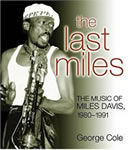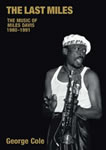The following is an extract from the introduction of The Last Miles: The Music Of Miles Davis 1980 to 1991:
Miles Davis entered my life at a relatively late age – when I was in my mid-twenties – but it’s no exaggeration to say that from that moment on, things would never quite be the same again. There is hardly a day when I don’t listen to the music of Miles Davis and there is hardly a time when his sound fails to move me. For anyone else who loves the music of Miles, this will not come as much surprise.
But what many people may find surprising, is that the music I play the most is not from Miles’ 50s period (when he recorded albums like Porgy and Bess and Kind of Blue) or the 60s (with the second great quintet of Wayne Shorter, Herbie Hancock, Ron Carter and Tony Williams). It isn’t even from the 70s, when Miles fused jazz with rock to produce masterpieces such as Jack Johnson and Bitches Brew. In fact, the music I play is mainly from Miles’ last decade, from 1981 to 1991.
I say surprising because a number of people I talk to (including some who are Miles’ fans) tend to dismiss this period, suggesting that at best, Miles was coasting and at worst, he had sold out and was more interested in being hip or making money. It is the contention of this book that this view is wrong and that Miles continued to make music that was fresh, challenging and engaging right up to his death. That isn’t to say that everything Miles played or recorded in this period was good, but in my view (and many of the people interviewed for this book), much of the music Miles made and played in his last decade has much value.
When I began this book, I set out to interview as many of the band members Miles had from 1981-91. The task took almost three years, but by the end, thirty-one of the thirty-six band members of Miles’ final decade had kindly agreed to share their memories of Miles with me (only one member could not be traced, despite my best efforts). It means that every guitarist, bassist and keyboardist Miles had in his last bands gives their story. As do many producers, session musicians and engineers.
Members of Miles’ road crew provided valuable insights into how Miles liked to sound when playing live. I also spoke to photographers and video directors who worked with Miles in this period, and they provide a fuller picture of the man. Insights from members who played with Miles before the 1980s also help us to understand a little more about Miles and his music.
No book about the music of Miles would be complete without a look at the music he played live on-stage and the biggest chapter is devoted to Miles’ live performances. This chapter also includes interviews with many musicians who never recorded with Miles and some who don’t even appear on the various live recordings released after Miles’ death.
Through their testaments, we hear how Miles recruited band members, how they learnt the music, how he directed them on-stage and why they left. Many also talk about Miles as a man, a musician and a band leader and reflect on their time with him. My hope is that after reading this book, you will have a much clearer idea about the music of Miles’ final decade and hopefully conclude that the music Miles’ made in this period cannot be simply dismissed.

